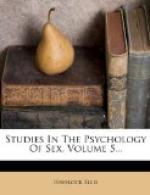[59] A. Hoche, Neurologische Centralblatt, 1896, No. 2.
[60] Op. cit., pp. 478, et seq.
[61] C.H. Hughes, “Morbid Exhibitionism,” Alienist and Neurologist, August, 1904. Another somewhat similar American case, also preceded by overwork, and eventually adjudged insane by the courts, is recorded by D.S. Booth, Alienist and Neurologist, February, 1905.
[62] Exhibitionism in epilepsy is briefly discussed by Fere, L’Instinct Sexuel, second edition, pp. 194-195.
[63] W.S. Colman, “Post-Epileptic Unconscious Automatic Actions,” Lancet, July 5, 1890.
VI.
The Forms of Erotic Symbolism are Simulacra of Coitus—Wide
Extension of Erotic Symbolism—Fetichism
Not Covering the Whole
Ground of Sexual Selection—It is Based
on the Individual Factor in
Selection—Crystallization—The
Lover and the Artist—The Key to Erotic
Symbolism to be Found in the Emotional Sphere—The
Passage to Pathological
Extremes.
We have now examined several very various and yet very typical manifestations in all of which it is not difficult to see how, in some strange and eccentric form—on a basis of association through resemblance or contiguity or both combined—there arises a definite mimicry of the normal sexual act together with the normal emotions which accompany that act. It has become clear in what sense we are justified in recognizing erotic symbolism.
The symbolic and, as it were, abstracted nature of these manifestations is shown by the remarkable way in which they are sometimes capable of transference from the object to the subject. That is to say that the fetichist may show a tendency to cultivate his fetich in his own person. A foot-fetichist may like to go barefoot himself; a man who admired lame women liked to halt himself; a man who was attracted by small waists in women found sexual gratification in tight-lacing himself; a man who was fascinated by fine white skin and wished to cut it found satisfaction in cutting his own skin; Moll’s coprolagnic fetichist found a voluptuous pleasure in his own acts of defecation. (See, e.g., Krafft-Ebing, Op. cit., p. 221, 224, 226; Hammond, Sexual Impotence, p. 74; cf. ante, p. 68.) Such symbolic transference seems to have a profoundly natural basis, for we may see a somewhat similar phenomenon in the well-known tendency of cows to mount a cow in heat. This would appear to be, not so much a homosexual impulse, as the dynamic psychic action of an olfactory sexual symbol in a transformed form.
We seem to have here a psychic process which is a curious reversal of that process of Einfuehlung—the projection of one’s own activities into the object contemplated—which Lipps has so fruitfully developed as the essence of every aesthetic condition. (T. Lipps,




